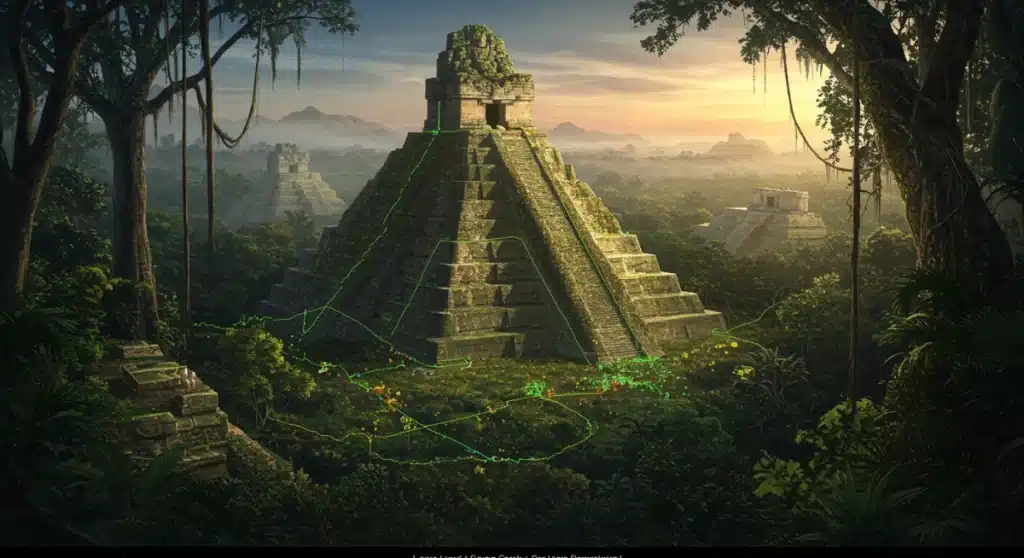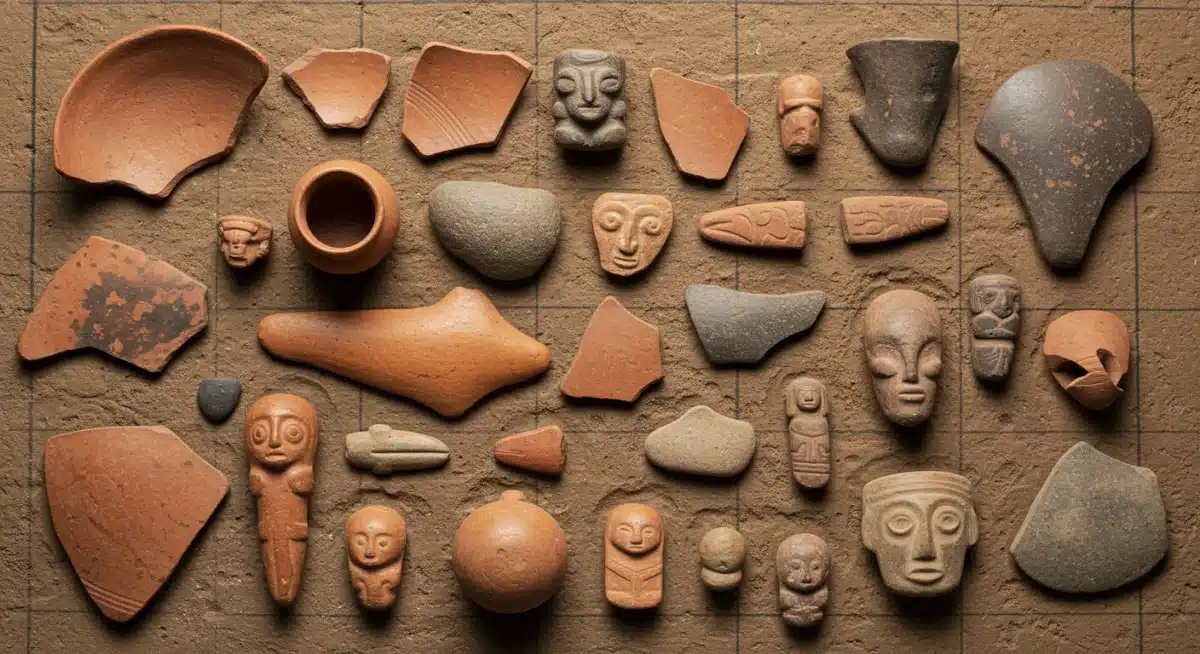New World Discoveries Redefining History: A Decade’s Impact

The past decade has been a period of unprecedented revelations, with a series of New World Discoveries History-making finds fundamentally reshaping our understanding of ancient American civilizations and their profound impact on human history. These breakthroughs challenge established timelines, unveil complex societies, and rewrite narratives previously thought settled.
Unmasking Ancient Maya Megacities
Recent advancements in remote sensing technology, particularly LiDAR (Light Detection and Ranging), have revolutionized archaeology, allowing researchers to peer beneath dense jungle canopies. This has led to the identification of vast, interconnected Maya urban centers far larger and more complex than previously imagined.
In 2018, an extensive LiDAR survey across Guatemala’s Petén region revealed over 60,000 previously unknown Maya structures, including urban centers with extensive defensive systems, agricultural terraces, and causeways. This discovery suggests a Maya population far greater than earlier estimates, potentially numbering in the tens of millions during the Late Classic period.
LiDAR’s Transformative Impact
LiDAR technology utilizes pulsed lasers to create detailed 3D maps of surfaces, effectively stripping away vegetation in the digital realm. This non-invasive method has proven invaluable in areas difficult to access or survey using traditional archaeological techniques.
- Uncovered extensive networks of ancient roadways.
- Revealed sophisticated agricultural infrastructure, including irrigation systems.
- Identified hidden ceremonial sites and residential compounds.
The Olmec Heartland: New Chronologies Emerge
New archaeological excavations in the Olmec heartland of Veracruz and Tabasco, Mexico, continue to push back the timeline for complex societal development in Mesoamerica. Discoveries made within the last ten years are shedding new light on the Olmecs, often considered the ‘mother culture’ of Mesoamerican civilizations.
Recent findings at sites like San Lorenzo and La Venta have provided more precise dating for monumental architecture and intricate artwork, suggesting that Olmec society was highly organized and engaged in long-distance trade much earlier than previously believed. These discoveries highlight the sophisticated astronomical knowledge and artistic prowess of these early inhabitants.
Patagonian Rock Art: A Glimpse into Deep Time
In the remote caves and rock shelters of Patagonia, new discoveries of ancient rock art are offering unprecedented insights into the lives of early hunter-gatherers in South America. Dating techniques applied to recently found pictographs and petroglyphs indicate human activity stretching back over 10,000 years, pushing the boundaries of known human presence in the region.
These artworks depict scenes of hunting, rituals, and abstract symbols, providing a visual narrative of archaic cultures. The sheer volume and preservation of these sites underscore Patagonia’s significance as a cradle of early human artistic expression and spiritual belief systems.
Ancient Amazonian Cities: Challenging Wilderness Narratives
For decades, the Amazon rainforest was largely considered a pristine wilderness with scattered, small settlements. However, recent archaeological work, again heavily aided by LiDAR, has unveiled extensive, highly organized urban landscapes hidden beneath the dense foliage. These discoveries dramatically alter our perception of pre-Columbian Amazonia.

In Ecuador, researchers identified a vast network of ancient cities connected by roads and agricultural fields dating back over 2,000 years. This monumental discovery, reported in 2024, reveals a society far more complex and populous than any previously imagined for the region, complete with monumental platforms and plazas. The implications are profound, suggesting advanced ecological management and social organization.
The Upano Valley Network
The Upano Valley in eastern Ecuador has become a focal point for these revelations. The scale of the urban planning and engineering discovered is comparable to that of the Maya lowlands or ancient Egypt.
- Identified residential areas, ceremonial platforms, and extensive drainage systems.
- Evidence of large-scale agricultural production to sustain dense populations.
- Sophisticated road systems facilitating trade and communication.
Norse Settlements in North America: Expanding the Narrative
While L’Anse aux Meadows in Newfoundland has long been recognized as the sole confirmed Norse settlement in North America, new evidence emerging in the last decade points to potential additional sites. These ongoing investigations are expanding our understanding of early European contact with the New World, pushing beyond the established narrative.
Archaeological surveys and analysis of potential artifacts at locations like Point Rosee, also in Newfoundland, have sparked debate and further exploration. Though not yet definitively confirmed as settlements, the systematic search and the types of anomalies found indicate a broader Norse presence than previously acknowledged, suggesting a more prolonged and widespread interaction with indigenous populations.
Early Human Migration Routes: Rewriting the Beringia Story
The traditional ‘Beringia land bridge’ theory for the peopling of the Americas has been continuously refined and challenged by new genetic and archaeological data over the past ten years. Discoveries now suggest multiple migration waves and coastal routes playing a more significant role than previously understood.
Evidence from submerged coastal sites and updated genetic analyses of ancient remains indicate that humans may have arrived in the Americas much earlier than the Beringian corridor opening would allow. These findings support a ‘coastal migration’ hypothesis, where early peoples used watercraft to navigate down the Pacific coast, encountering diverse environments and establishing settlements along the way.
Genetic and Archaeological Convergence
The synergy between genetic research and archaeological excavations is crucial in this evolving narrative. DNA analysis from ancient human remains provides critical clues about population movements and relationships.
- Confirmation of distinct ancestral lineages in early American populations.
- Dating of human presence in South America preceding established Beringian timelines.
- Identification of potential refugia during glacial maximums.
Underwater Discoveries: Submerged Landscapes and Artifacts
The rising sea levels since the last Ice Age have submerged vast coastal landscapes, preserving archaeological sites that offer unique windows into ancient human life. Over the last decade, underwater archaeology has yielded incredible discoveries, particularly along the Gulf of Mexico and Caribbean coastlines.
In Florida, a submerged site known as the “Manasota Key Offshore” (MKO) burial ground, discovered in 2016, revealed human remains dating back over 7,000 years. This unprecedented find provides direct evidence of early archaic populations living on now-submerged landmasses, offering insights into their mortuary practices and adaptation to coastal environments.
The Nazca Lines: New Figures and Interpretations
Peru’s enigmatic Nazca Lines continue to captivate researchers, and the past decade has brought forth new discoveries and interpretations. Drone technology and advanced imaging have identified previously unnoticed geoglyphs, adding to the vast collection of desert etchings.
These new figures, including representations of felines, humans, and other abstract designs, are often smaller and predate some of the more famous Nazca animal figures. Their discovery prompts a re-evaluation of the purpose and chronology of these monumental artworks, suggesting multiple phases of creation and potentially different cultural meanings over time.
Cahokia’s Reach: Reassessing Mississippian Influence
Cahokia, near modern-day St. Louis, was once the largest pre-Columbian city north of Mexico. Recent archaeological work has expanded our understanding of its influence and the broader Mississippian culture. New evidence suggests a more extensive network of trade, cultural exchange, and political influence emanating from Cahokia than previously acknowledged.
Discoveries of Cahokian-style pottery, tools, and architectural elements at distant sites indicate a complex system of interaction across vast regions of the American Midwest and Southeast. This challenges the notion of isolated communities, highlighting a sophisticated, interconnected Mississippian world.
Pre-Clovis Sites: Pushing Back Human Presence
The ‘Clovis First’ paradigm, which posited that the Clovis culture was the first widespread human presence in the Americas, has been definitively overturned by discoveries in the last decade. Multiple pre-Clovis sites, with compelling evidence of human occupation dating back 14,000 to 20,000 years or more, are rewriting the timeline of human arrival.
Sites like the Gault site in Texas and the Cooper’s Ferry site in Idaho have yielded undeniable artifacts and evidence of human activity predating Clovis by several millennia. These findings provide crucial data for understanding the earliest inhabitants of the New World, their technologies, and their adaptation strategies to diverse environments.
| Key Discovery | Brief Description |
|---|---|
| Maya Megacities (LiDAR) | LiDAR technology revealed over 60,000 unknown Maya structures, indicating a much larger population and complex urban planning. |
| Ancient Amazonian Cities | LiDAR uncovered extensive urban networks in Ecuador, challenging previous notions of a ‘pristine’ Amazonian wilderness. |
| Pre-Clovis Sites | New archaeological evidence definitively pushes back the timeline of human arrival in the Americas, predating Clovis culture. |
Frequently Asked Questions About New World Discoveries
LiDAR (Light Detection and Ranging) is a remote sensing method that uses pulsed laser light to measure distances, creating detailed 3D maps. It has revolutionized New World archaeology by penetrating dense jungle canopies, revealing vast ancient cities and structures previously hidden from view, like Maya megacities.
Recent LiDAR-assisted discoveries in the Amazon, particularly in Ecuador, have unveiled extensive urban networks with roads and monumental architecture. This fundamentally alters the perception of Amazonia as an untouched wilderness, showing it was home to complex, densely populated societies thousands of years ago.
Pre-Clovis sites are archaeological locations that provide evidence of human presence in the Americas before the Clovis culture, which was long thought to be the earliest. These discoveries, dating back 14,000 to 20,000 years or more, rewrite the timeline of human migration to the continent, challenging established theories.
While L’Anse aux Meadows remains the only definitively confirmed Norse settlement, new archaeological evidence and ongoing investigations at other sites, such as Point Rosee in Newfoundland, suggest potential additional Norse presence. These findings are expanding the narrative of early European contact with the New World, though not yet fully confirmed.
Genetic studies, particularly DNA analysis from ancient human remains, are crucial for tracing population movements and ancestral lineages. They provide critical data that complements archaeological findings, helping to confirm theories like the coastal migration hypothesis for early human arrival and refining our understanding of ancient population dynamics.
Impact and Implications
The rapid pace of archaeological discovery in the New World signifies a profound shift in our understanding of human history. These findings, particularly those enabled by new technologies like LiDAR and advanced genetic analysis, are not merely adding details but fundamentally rewriting narratives about ancient civilizations, migration patterns, and technological prowess. The implications extend beyond academia, influencing how we perceive indigenous histories and the complex interactions between humans and their environment over millennia. Researchers anticipate continued breakthroughs, promising even greater clarity on the rich, multifaceted past of the Americas.